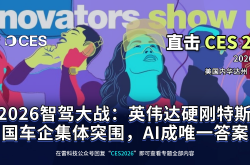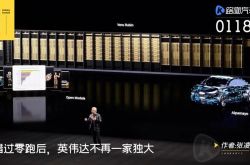Will L4 Autonomous Driving See Trial Commercialization in 2027, Partial Rollout in 2030, and Widespread Adoption by 2035? How Reliable Is Huawei's Forecast?
![]() 09/18 2025
09/18 2025
![]() 856
856
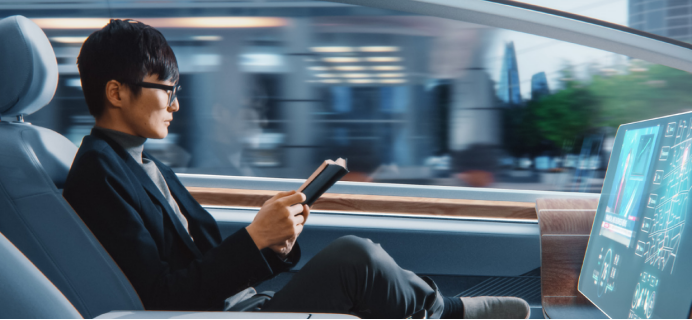
"We expect to launch trial commercialization of L4-level autonomous driving by the end of 2027, achieve large-scale L4 deployment in specific scenarios by 2030, and ultimately reach L4+ autonomous driving capabilities in most scenarios by 2035. Simultaneously, we will also begin exploring trial commercialization of L5-level autonomous driving."
On September 16th, Huawei made these forward-looking predictions.
On that day, Wang Tao, Executive Director of Huawei, unveiled the significant report titled "Intelligent World 2035" (hereinafter referred to as the "2035 Report") on behalf of Huawei.
In the realm of autonomous driving, which is our focal point, Huawei outlined the aforementioned timeline and highlighted that world model technology will underpin the development of L3-level autonomous driving, while L4-level autonomous driving will hinge on AGI (Artificial General Intelligence) technology as its cornerstone.
Additionally, Huawei disclosed the top ten technology trends for the intelligent world in 2035 in the 2035 Report. Let's take a peek into the "future" together.
01 Autonomous Driving Timeline
Looking ahead, the 2035 Report suggests that embodied intelligence will bridge existing gaps, giving rise to multiple trillion-dollar industries.
Among the three major sectors of embodied intelligence lies intelligent driving. The 2035 Report is even more optimistic, stating that intelligent driving has already overcome technological barriers and will achieve L4+ autonomous driving capabilities by 2035.
The report recalls that in 2022, following the implementation of light-mapping solutions based on the Transformer architecture, Bird's Eye View (BEV), and Occupancy Network, the intelligent driving industry successfully surmounted the technological hurdle of L2+ level, propelling the industry into a period of explosive growth. Subsequently, with the rapid rise in electric vehicle penetration rates worldwide (especially in the Chinese market, where numerous models come standard with L2+ functions) and the continuous boost from Robotaxi services, current intelligent driving is gradually approaching the threshold of L3 level.
What technologies underpin L3-level autonomous driving?
The report suggests that the industry is expected to first achieve this through the End-to-End (E2E) technical route, followed by gradual upgrades to L3+ level in highway and urban scenarios, driven by technological breakthroughs in the World Model.
Regarding the roadmap for higher-level autonomous driving, the report predicts the initiation of trial commercialization of L4-level by the end of 2027, large-scale L4 deployment in specific scenarios by 2030, and ultimately reaching L4+ autonomous driving capabilities in most scenarios by 2035, while also embarking on trial commercialization exploration of L5-level.
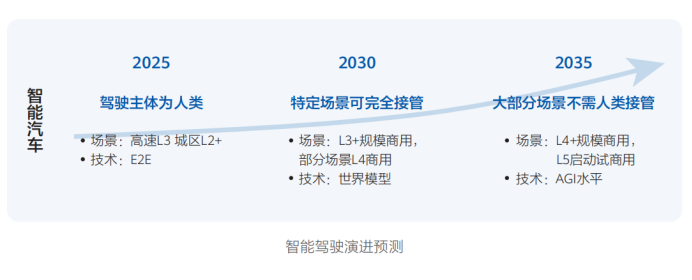
Specifically in terms of scenarios, it is predicted that by 2035, RoboTaxi (autonomous taxis) will become an indispensable cornerstone of the global urban transportation ecosystem, with the market size expanding to the trillion-dollar level.
The 2035 Report also includes low-altitude flight as one of the industries of embodied intelligence.
The report points out that the low-altitude economy faces multiple challenges: 1) Insufficient battery energy density, with unresolved range issues; 2) Imperfect infrastructure, constraining business development speed; 3) High prices and costs, unclear business models, affecting aircraft popularity; 4) Policy and regulatory barriers, as well as airworthiness certification obstacles, lacking relevant standards, and cautious airspace control; 5) Aircraft safety and the resulting social security issues still require effective solutions.
However, future key breakthrough directions may include high-energy-density solid-state batteries, solar-hydrogen-electric multi-source coupling, and hybrid range extension with batteries and liquid generators.
In the three major flight stages, enhancing individual aircraft intelligence and combining it with a low-altitude intelligent network can promote efficient low-altitude flight operations.
The report predicts that by 2035, the vision of families owning private aircraft may become a reality.
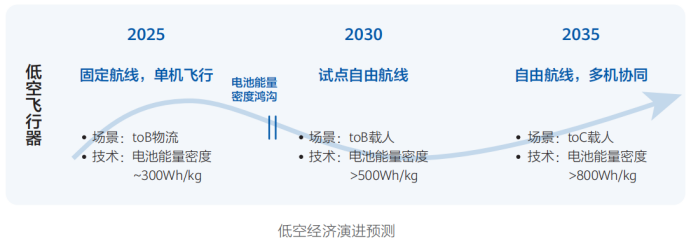
02 Cars Transforming into the Third Living Space
Under the premise of widespread autonomous driving, vehicles are transforming from mere transportation tools into mobile "third living spaces."
Taking Robotaxi as an example, the report suggests that commuters can subscribe to an "office cabin" to seamlessly connect to a secure network and hold video conferences during their commute; young people can book an "entertainment cabin" for immersive audio-visual gaming experiences; families can opt for a "parent-child cabin" equipped with interactive games and child safety monitoring systems. Robotaxi truly realizes the "recreation of the value of travel time," converting previously wasted commuting time into efficient periods for work, entertainment, or rest.
Robotaxi can also deeply integrate into the urban public service system. For instance, a "mobile clinic" linked to the medical system can provide on-door basic health check-ups for elderly individuals with mobility issues, with intelligent diagnostic equipment in the vehicle transmitting data in real-time to community doctors. In emergency scenarios, the Robotaxi fleet can be dispatched with a single click to prioritize public tasks such as medication delivery and personnel evacuation, becoming an agile terminal of the urban emergency response system.
In terms of commercial development, the vehicle space of RoboTaxi has become a new carrier for offline retail and services. Users can place orders on e-commerce platforms and then book a "mobile fitting room" RoboTaxi to complete try-ons and returns on their way home from work. Catering brands can launch "mobile food bars" to provide hot meals at users' designated times and locations. This model transforms "people seeking goods" into "goods seeking people," greatly enhancing the consumer experience and commercial efficiency.
In summary, the Robotaxi of 2035 is not just a transportation tool; it is more akin to intelligent, mobile super terminals.
03 Top Ten Intelligent Technology Trends for 2035
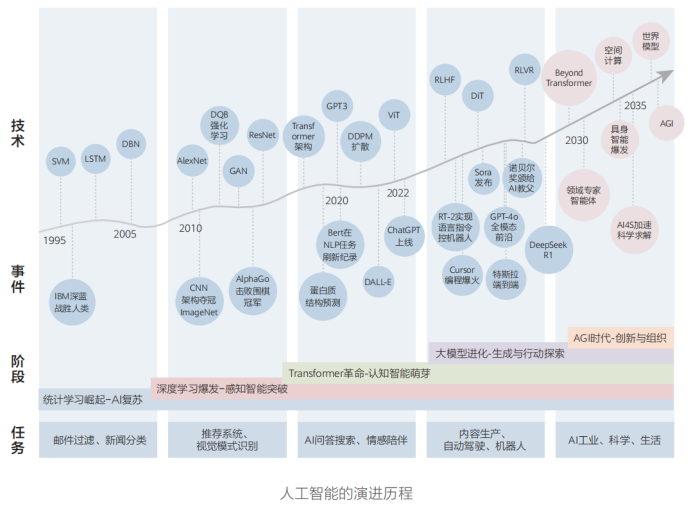
Since 2021, Huawei has been releasing the Intelligent World report, systematically depicting and forecasting industry trends for the intelligent world in the next decade.
This report has been updated to "Intelligent World 2035" and, as per tradition, unveils ten technology trends.
Trend 1: AGI will be the most transformative driving force in the next decade, but it still needs to overcome numerous core challenges to achieve the AGI singularity breakthrough. Therefore, venturing into the physical world is the inevitable path for AGI formation.
Trend 2: With the development of large models, AI agents will evolve from execution tools into decision-making partners, driving an industrial revolution.
Trend 3: The development model is undergoing a transformation, with human-machine collaborative programming becoming mainstream. Humans will focus more on top-level design and innovative thinking, while delegating tedious coding tasks to efficient AI.
Trend 4: Interaction methods are shifting from graphical interfaces to natural language, evolving towards multimodal interactions that integrate the five human senses. Users can interact with the digital world through voice, gestures, etc., obtaining deeply immersive experiences.
Trend 5: Mobile apps are transforming from independent functional entities into service nodes driven by AI agents. Users only need to give instructions, and the AI agent will invoke relevant service nodes to provide users with an ultimate experience.
Trend 6: With breakthroughs in key technologies such as world models, brand-new L4+ autonomous vehicles will enter people's lives, becoming "mobile third spaces."
Trend 7: By 2035, the total computing power of society will increase 100,000-fold. The computing field will break free from the constraints of the traditional Von Neumann architecture, achieving disruptive innovations in four core aspects: computing architecture, material devices, engineering processes, and computing paradigms, ultimately giving rise to the comprehensive emergence of new computing methods.
Trend 8: Data will become the "new fuel" driving artificial intelligence development. The demand for AI storage capacity will increase 500-fold compared to 2025, accounting for over 70%, with Agentic AI driving changes in storage paradigms.
Trend 9: The connection objects of communication networks will expand from 9 billion people to 900 billion intelligent agents, achieving a leap from the mobile internet to the internet of agents.
Trend 10: Energy will become a core factor constraining the rapid development of AI. By 2035, renewable energy will accelerate its replacement of traditional fossil fuels, with the proportion of new energy generation exceeding 50%. Meanwhile, artificial intelligence will become the core of the new energy system, managing watts through tokens and real-time management of every joule of energy, thereby achieving a more dynamic and efficient power grid.
These predictions showcase Huawei's comprehensive and in-depth layout and insights in the AI field, but they only represent Huawei's perspective. For instance, in terms of autonomous driving technology, some players believe that L3-level autonomous driving can be achieved based on the VLA large model, rather than the world model.
Certainly, Huawei's timeline and technical solutions can serve as important reference points for observing the industry. Let's see if anyone can outpace it with more cutting-edge technologies.
-END-

